Food & Beverage
How to Cook a Baked Potato in the Microwave? A Quick and Delicious Meal Solution
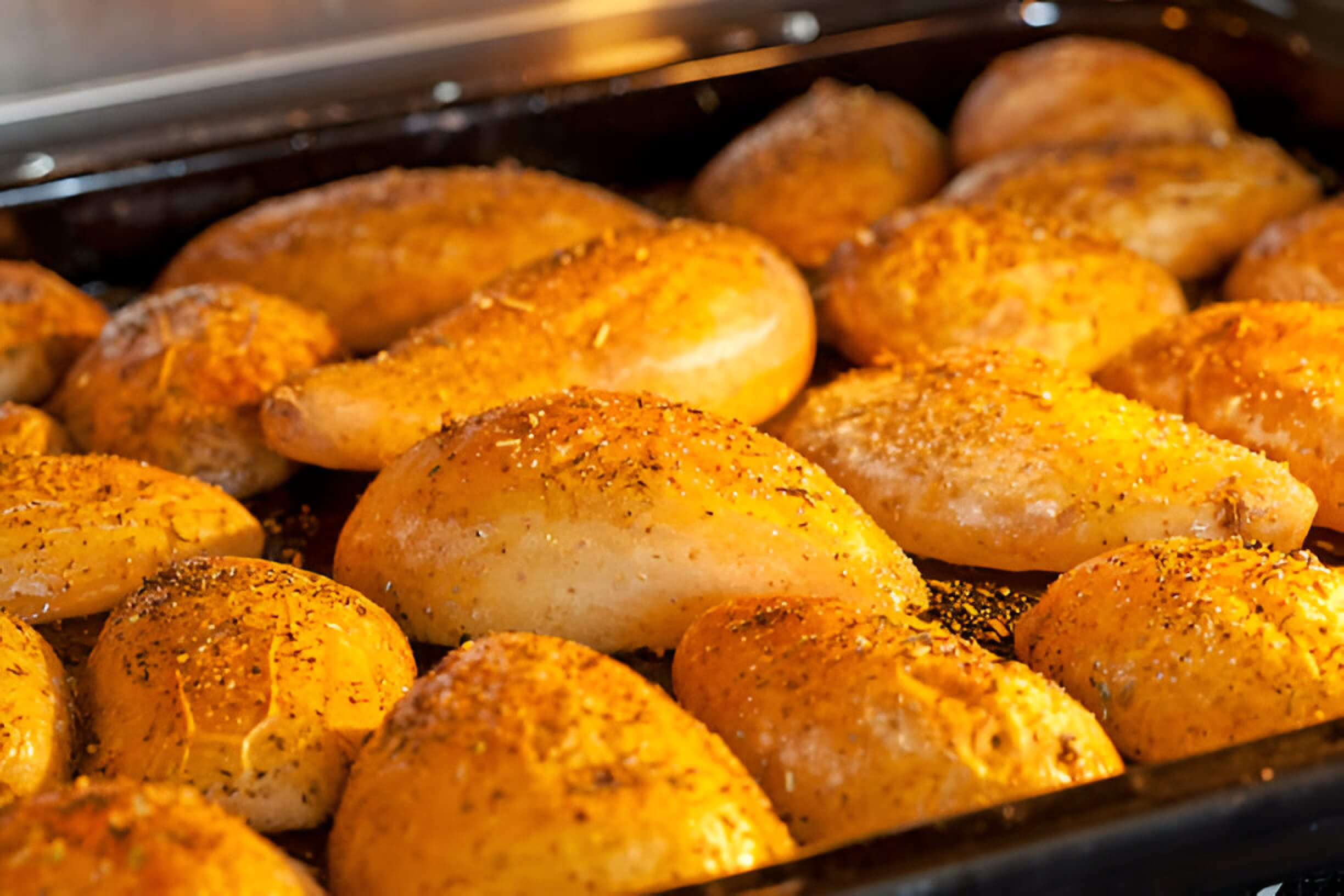
Craving a comforting baked potato but short on time? Microwaving offers a quick and easy solution. This guide will walk you through the simple steps to achieve a perfectly cooked baked potato using your microwave. From selecting the right potato to mastering the cooking technique, you’ll learn how to create a delicious, fluffy baked potato in a fraction of the time it takes to use a conventional oven.
Selecting the Perfect Potato for Microwaving
When it comes to selecting the perfect potato for microwaving, not all spuds are created equal. Russet potatoes are widely considered the best choice due to their high starch content and thick skin, which helps them retain moisture during cooking. These qualities ensure a fluffy interior and crispy exterior when microwaved.
Size matters when choosing potatoes for microwaving. Opt for medium-sized potatoes, roughly 4-6 ounces each, as they cook more evenly and thoroughly. Larger potatoes may require longer cooking times and can result in uneven heating, while smaller ones might overcook quickly.
For even cooking, select potatoes of similar size and shape. This uniformity allows for consistent cooking times and results. Before microwaving, be sure to wash the potatoes thoroughly and pierce them several times with a fork to allow steam to escape during cooking.
By choosing the right type and size of potato, you can ensure a perfectly cooked, delicious microwave potato every time. Remember, the key to success lies in selecting high-quality russet potatoes of medium size for optimal results in your microwave cooking adventures.
Preparing Your Potato for the Microwave
Before microwaving your potato, proper preparation is essential for both safety and optimal cooking results. Start by thoroughly washing the potato under cool running water, using a vegetable brush to scrub away any dirt or debris from the skin. This step ensures cleanliness and removes potential contaminants.
Once clean, it’s crucial to pierce the potato’s skin several times with a fork. These small pricks allow steam to escape during cooking, preventing the potato from exploding in the microwave. Aim for 6-8 evenly spaced fork pricks around the potato’s surface.
The piercing process is not just a precautionary measure; it also helps the potato cook more evenly by allowing heat to penetrate the dense flesh more efficiently. Remember, skipping this step can lead to a messy microwave and a ruined potato, so always take the time to properly prepare your spud before cooking.
Essential Tools and Materials for Microwave Baked Potatoes
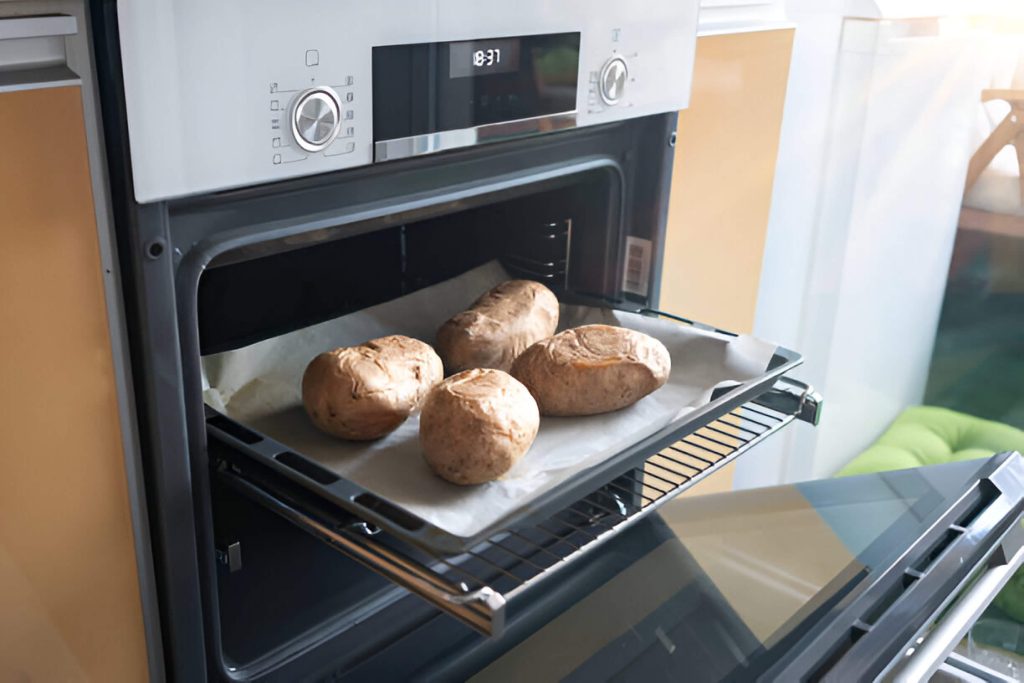
To prepare perfect microwave baked potatoes, you’ll need a few essential tools and materials. First and foremost, a microwave-safe plate is crucial for safely cooking your potatoes. This ensures even heating and prevents any potential damage to your microwave.
A paper towel is another important item, as it helps absorb excess moisture during cooking and keeps the potato skin from becoming too soggy. When selecting potatoes, choose ones of similar size to ensure consistent cooking times.
It’s important to note that microwave wattage can vary, affecting cooking times. Higher wattage microwaves will cook potatoes faster, so adjust your cooking time accordingly. A general rule of thumb is to start with 5 minutes for the first potato and add 2-3 minutes for each additional one.
For best results, consider using microwave-safe plastic wrap to cover your potatoes. This traps steam and helps cook the potatoes more evenly. However, be sure to prick the plastic wrap a few times to allow excess steam to escape.
By having these tools and materials on hand and understanding your microwave’s capabilities, you’ll be well-equipped to create delicious microwave baked potatoes with minimal effort.
Step-by-Step Cooking Process in the Microwave
Mastering the art of microwave cooking involves understanding the right settings and techniques. Begin by selecting the appropriate power level, typically high for most dishes. Next, set the cooking duration, which varies depending on the food and quantity. For items like potatoes, start with 5-7 minutes per potato.
Remember to flip or rotate your food halfway through cooking for even heat distribution. When microwaving potatoes, for instance, turn them over at the halfway point. This ensures uniform cooking and prevents cold spots.
To check for doneness, use a food thermometer to measure the internal temperature. For most cooked dishes, aim for at least 165°F (74°C). If additional cooking time is needed, continue microwaving in short intervals, checking frequently to avoid overcooking.
Always allow for standing time after microwaving, as the food continues to cook even after the microwave stops. This resting period helps distribute heat evenly and completes the cooking process, ensuring a perfectly cooked meal.
Adding Toppings and Flavoring Your Microwave Baked Potato
Once your microwave baked potato is ready, it’s time to elevate its flavor with delicious toppings. Classic options include a pat of butter, a dollop of sour cream, or a sprinkle of shredded cheese. For added texture and taste, consider crumbled bacon bits or finely chopped chives. Don’t forget to season with salt and pepper to enhance the overall flavor profile.
For those seeking healthier alternatives, try Greek yogurt instead of sour cream, or opt for low-fat cheese. Steamed broccoli, diced tomatoes, or sliced avocado can add nutritional value and freshness. Experiment with different herbs like rosemary or thyme for an aromatic twist.
Remember, the beauty of a baked potato lies in its versatility. Mix and match toppings to create your perfect combination, whether you prefer a loaded potato bursting with flavors or a simpler, more refined approach. The possibilities are endless, allowing you to customize your microwave baked potato to suit your taste preferences and dietary needs.
Tips for Achieving the Perfect Texture and Flavor
Achieving the perfect texture and flavor when cooking a baked potato in the microwave requires a few key techniques. Start by thoroughly washing and drying your potato, then pierce it several times with a fork to allow steam to escape. For a crispy skin, rub the potato with a small amount of oil and sprinkle with salt before microwaving. Cook the potato on high for about 5 minutes per side, depending on its size.
To ensure a fluffy interior, avoid wrapping the potato in foil while microwaving, as this can create a steamed rather than baked texture. Instead, cover the potato with a damp paper towel to retain moisture. After cooking, allow the potato to rest for a few minutes to complete the cooking process and achieve an even texture throughout.
Seasoning techniques can elevate your microwave-baked potato. Try rubbing the skin with herbs like rosemary or thyme before cooking, or experiment with different types of salt and pepper. Once cooked, gently fluff the interior with a fork before adding your favorite toppings. By following these tips, you can create a delicious baked potato with a satisfying contrast between the crispy skin and fluffy interior, all in a fraction of the time it takes to bake in an oven.
Troubleshooting Common Issues with Microwave Baked Potatoes
Microwave baked potatoes can be a quick and convenient meal option, but they sometimes come with their own set of challenges. Here are some common issues and how to address them:
Undercooked potatoes: If your potato is still firm in the center, it needs more cooking time. Microwave in additional 1-minute increments until fully cooked. Remember to pierce the skin with a fork before cooking to allow steam to escape.
Overcooked potatoes: To avoid this, start with shorter cooking times and increase as needed. Different potato sizes require different cooking durations, so adjust accordingly.
Uneven cooking: Rotate the potato halfway through cooking to ensure even heat distribution. For multiple potatoes, arrange them in a circle with space between each one.
Dry potatoes: Wrap the potato in a damp paper towel before microwaving to retain moisture. Alternatively, place a small cup of water in the microwave alongside the potato.
Soggy skin: For a crispy skin, briefly finish the potato in a conventional oven or under the broiler after microwaving. You can also try using a microwave crisper pan for better results.
By addressing these common issues, you can perfect your microwave baked potato technique and enjoy a satisfying meal with minimal effort.
Food & Beverage
What is Boba Made Of and How to Make It
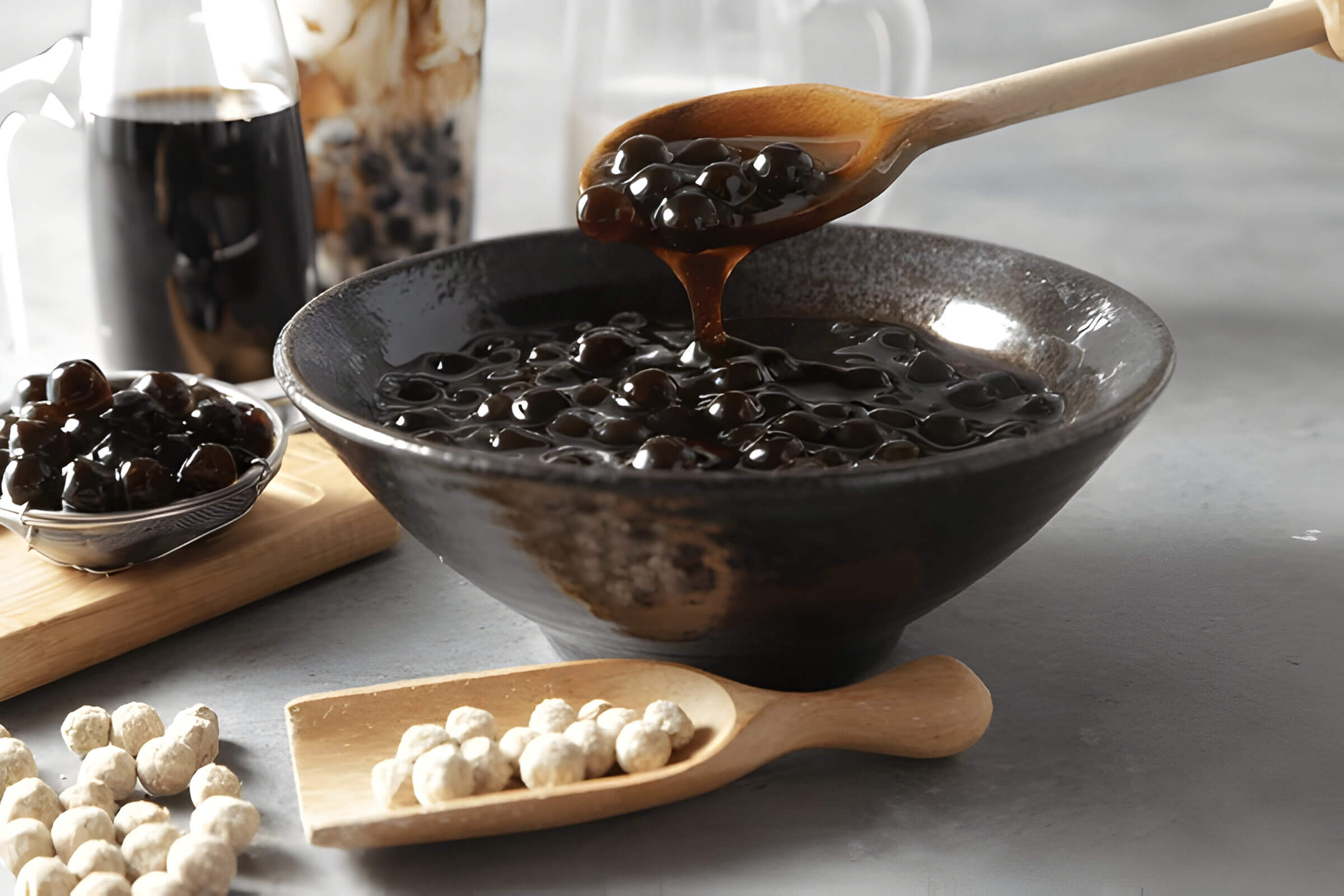
Boba tea, or bubble tea, combines chewy tapioca pearls and flavorful tea. Originating in Taiwan in the 1980s, it has become a global sensation with diverse flavors and textures. This guide explores the uniqueness of tapioca pearls, and provides a step-by-step recipe to make your own. Whether you’re a seasoned fan or new to this trendy drink, join us on a journey through the world of bubble tea.
What is Boba Made Of? Understanding the Ingredients
Boba, also known as bubble tea, has become a beloved beverage worldwide, but many people are curious about what gives boba its unique texture and flavor. The primary ingredient in boba is tapioca pearls, which are responsible for the drink’s signature chewy texture. These pearls are made from tapioca starch derived from the cassava root.
The process begins by extracting starch from the cassava root. This starch is then mixed with water and other ingredients to form a dough-like consistency. Small balls are rolled out of this dough and cooked until they achieve their characteristic chewy texture. The cooking process typically involves boiling the pearls until they become soft yet resilient.
In addition to traditional white tapioca pearls, black pearls are also popular in boba drinks. These black pearls get their color from brown sugar or caramel added during the preparation process, giving them a slightly sweeter taste compared to their white counterparts.
Understanding these key ingredients (tapioca starch from cassava root and optional sweeteners) helps us appreciate the craftsmanship behind every cup of bubble tea. Whether you prefer your boba with milk tea or fruit flavors, knowing what goes into making those delightful chewy pearls can enhance your overall experience of this trendy beverage.
The Science Behind the Chewy Texture of Boba Pearls
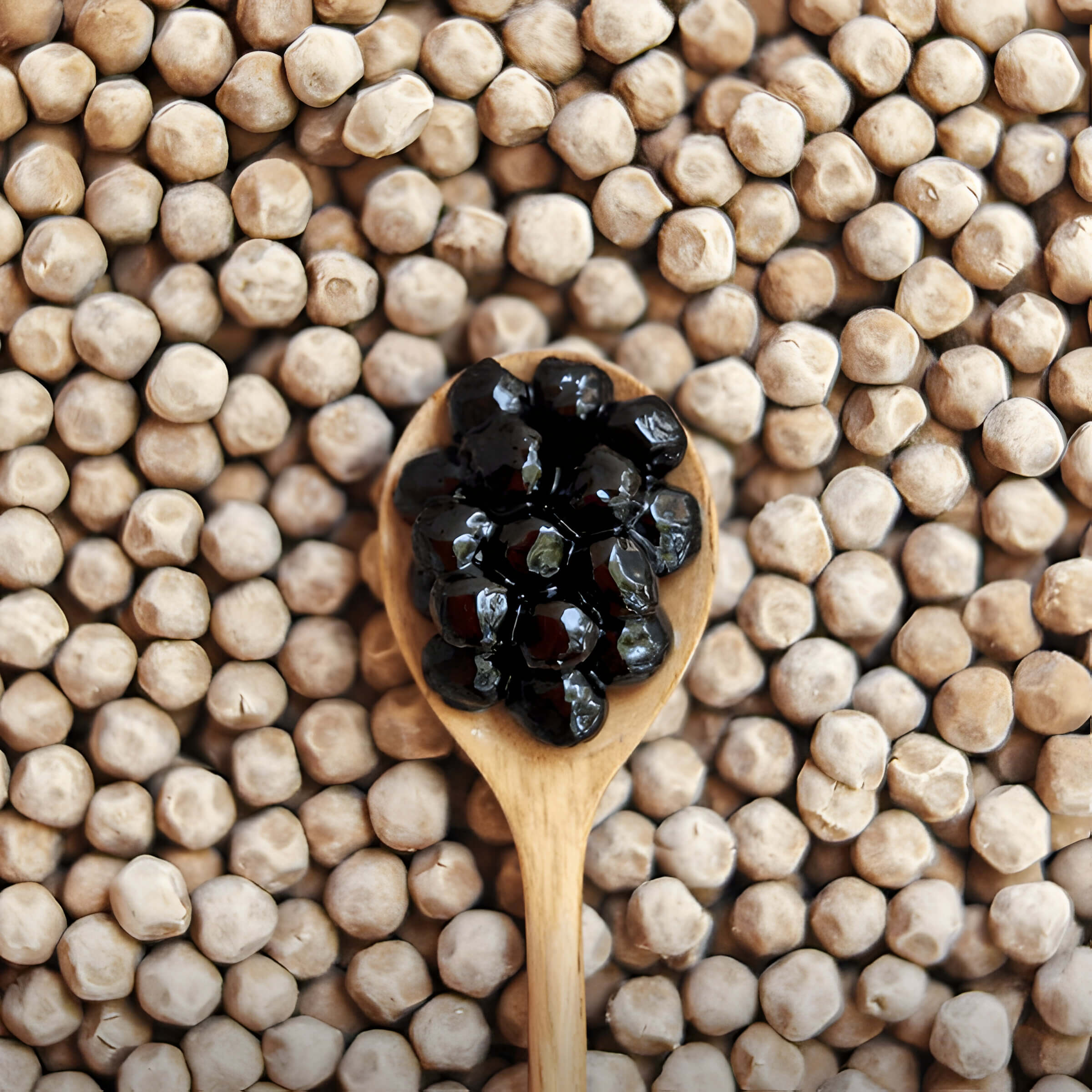
Boba pearls, those delightful chewy spheres found in bubble tea, owe their unique texture to the properties of tapioca starch. Tapioca starch, derived from the cassava root, has a high amylose content which plays a crucial role in creating the gelatinous texture that boba enthusiasts love.
During the cooking process of boba pearls, tapioca starch is mixed with boiling water to form a dough. This dough is then rolled into small balls and cooked again in boiling water. The heat causes the starch granules to swell and gelatinize, forming a network that traps water and creates that characteristic chewiness.
The precise balance of temperature and time during cooking is essential to achieve perfect boba pearls. Overcooking can lead to overly soft pearls, while undercooking results in hard centers. Mastering this process ensures that each pearl maintains its delightful bite (firm yet yielding), which is a textural experience that’s central to enjoying boba tea.
Understanding these scientific principles not only enhances our appreciation for this popular treat but also opens up possibilities for experimenting with different textures by adjusting variables like cooking time and temperature.
How to Make Boba Pearls at Home: Step-by-Step Guide
Making boba pearls at home can be a fun and rewarding experience. This step-by-step guide will walk you through the process of creating your own chewy tapioca pearls, perfect for your homemade bubble tea.
Ingredients for Making Boba at Home
To get started, you’ll need the following ingredients:
– 1 cup of tapioca starch
– 1/2 cup of water
– 2 tablespoons of brown sugar (or black sugar for a richer flavor)
– A pinch of food coloring (optional)
Step-by-Step Guide to DIY Boba Pearls Recipe
Step 1. Preparing the Dough
Begin by heating the water and brown sugar in a small pot over medium heat. Stir until the sugar is completely dissolved. Once it reaches a gentle boil, gradually add half of the tapioca starch while continuously stirring to avoid lumps. The mixture will start to thicken quickly.
Step 2. Forming the Dough
Remove the pot from heat and add the remaining tapioca starch. Mix well until it forms a dough-like consistency. If it’s too sticky, add more tapioca starch as needed.
Step 3. Shaping the Pearls
Once your dough is ready, let it cool slightly before handling it. Roll small portions of dough into long thin ropes on a flat surface dusted with tapioca starch to prevent sticking. Cut these ropes into small pieces and roll each piece between your palms to form tiny balls or pearls.
Step 4. Cooking the Boba Pearls
Bring a large pot of water to boil and add your homemade boba pearls. Stir occasionally to prevent them from sticking together. Cook for about 15-20 minutes or until they float to the surface and achieve that signature chewy texture.
Step 5. Sweetening Your Pearls (Optional)
For added sweetness, you can soak your cooked boba pearls in simple syrup made from equal parts water and brown sugar.
Now that you have your homemade tapioca pearls ready, you can add them to your favorite bubble tea recipe or any other drink you’d like!
The Perfect Bubble Tea Recipe (Combining Tea and Boba Pearls)
Creating the perfect bubble tea recipe at home is easier than you might think. Here’s how to brew bubble tea that rivals your favorite shop’s offerings.
Start by preparing the boba pearls. Bring a pot of water to a boil and add the tapioca pearls, cooking them until they float to the surface and achieve a chewy consistency. This typically takes about 5-7 minutes. Once cooked, drain the pearls and rinse them with cold water before soaking them in a simple syrup made from equal parts sugar and water.
Next, focus on brewing your tea base. For classic bubble tea flavors like black or green milk tea with boba, steep high-quality loose-leaf black or green tea in hot water for 3-5 minutes. The strength of your brew will greatly influence the final taste of your bubble tea.
To assemble your drink, combine the brewed tea with milk or a non-dairy alternative to create a creamy texture. Sweeten it to taste using sugar or flavored syrups. Fill a glass with ice cubes, pour in your milk-tea mixture, and then add the soaked boba pearls.
Experimenting with different teas and flavorings can lead you to discover new favorites while mastering how to brew bubble tea at home. Whether you prefer traditional options like jasmine green milk tea or adventurous blends like taro or matcha, this versatile drink offers endless possibilities for customization. Enjoy crafting your perfect cup of bubble tea!
Exploring Different Flavors and Variations of Bubble Tea
When exploring bubble tea variations, one can start with the basic distinction between creamy and fruity bubble teas. Creamy bubble teas often use milk or non-dairy alternatives as their base, resulting in a rich and smooth texture. Popular examples include classic milk tea, taro milk tea, and matcha latte. These variations are typically paired with chewy tapioca pearls or other add-ins like pudding or jelly.
On the other hand, fruit-flavored bubble teas offer a refreshing alternative to their creamy counterparts. These beverages usually feature a blend of fruit juices or purees mixed with green or black tea. Some popular choices include mango, strawberry, and passion fruit bubble teas. The vibrant flavors make these drinks particularly appealing during warmer months.
Whether you prefer the indulgent creaminess of traditional milk teas or the zesty freshness of fruit-flavored options, there is undoubtedly a bubble tea variation that will satisfy your cravings. As you explore different flavors and combinations, you’ll discover why this versatile drink continues to captivate taste buds around the globe.
Food & Beverage
How is Vinegar Made and How Can It Be Made at Home? A Step-by-Step Guide
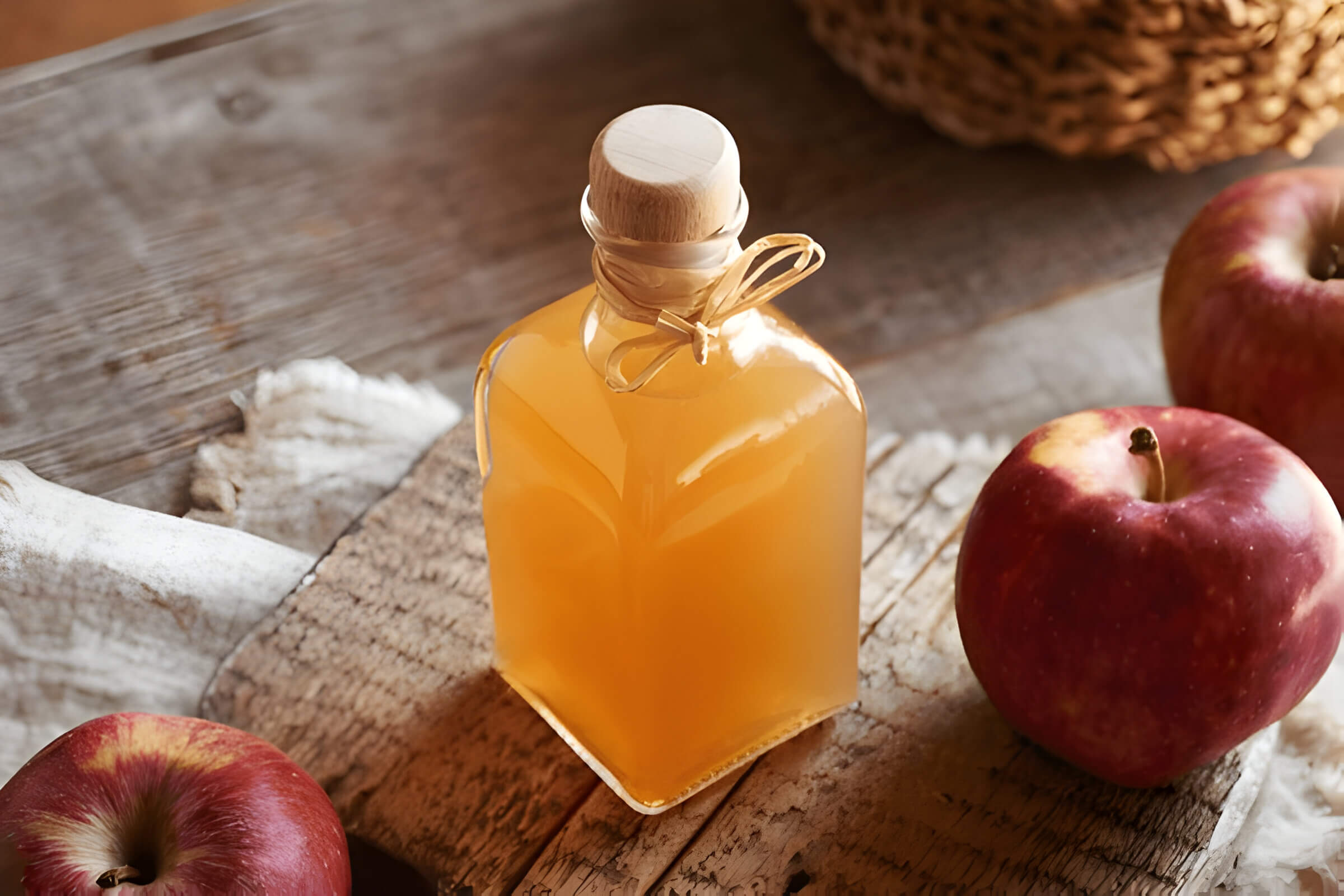
Vinegar, a kitchen staple worldwide, has a rich history and versatile applications. This guide explores the science behind vinegar production, detailing the fermentation process where alcohol turns into acetic acid with specific bacteria. It covers both commercial methods and home crafting essentials. Whether you’re troubleshooting issues or discovering benefits of homemade vinegar, this guide provides valuable insights for all DIY enthusiasts.
The Science Behind Vinegar Production
Vinegar, a staple in kitchens around the world, owes its unique tangy flavor to a fascinating biochemical process. At the heart of vinegar production is the vinegar fermentation process, which involves the conversion of alcohol into acetic acid. This transformation is primarily driven by acetic acid bacteria (AAB), a group of microorganisms that thrive in environments rich in ethanol.
The journey from alcohol to acetic acid begins when these bacteria oxidize ethanol (the type of alcohol found in beverages like wine and beer) to produce acetic acid. This biochemical reaction occurs in two main stages: first, ethanol is converted into acetaldehyde by an enzyme called alcohol dehydrogenase; then, acetaldehyde is further oxidized into acetic acid by another enzyme known as aldehyde dehydrogenase.
For optimal vinegar production, specific conditions must be maintained. The presence of oxygen is crucial since AAB are aerobic organisms that require oxygen to function effectively. Additionally, temperature and pH levels need to be carefully controlled to ensure the bacteria remain active and productive throughout the fermentation process.
Understanding this intricate interplay between microorganisms and their environment not only highlights the complexity behind something as simple as vinegar but also underscores the importance of scientific principles in everyday food production processes.
Commercial Methods of Making Vinegar
Vinegar, a versatile and widely used product, is produced through various commercial methods to meet the demands of different industries. Industrial vinegar production primarily involves large-scale fermentation processes that efficiently convert ethanol into acetic acid. The two main commercial vinegar making methods are the Orleans process and the submerged fermentation process.
The Orleans Process is one of the oldest methods of producing vinegar on a commercial scale. It relies on natural fermentation, where alcohol-containing liquids such as wine or cider are exposed to air in wooden barrels. Over time, acetic acid bacteria convert the ethanol into acetic acid. This method is known for producing high-quality vinegar with rich flavors but is relatively slow and less efficient for large-scale production.
In contrast, the Submerged Fermentation Process is commonly used in modern industrial settings due to its efficiency and scalability. This method employs stainless steel fermenters with continuous aeration systems that supply oxygen to submerged cultures of acetic acid bacteria. The constant supply of oxygen accelerates the conversion rate of ethanol to acetic acid, allowing for rapid production cycles and higher yields compared to traditional methods.
Both these commercial vinegar-making methods play crucial roles in ensuring a steady supply of this essential condiment across various sectors, from culinary applications to industrial uses like cleaning agents and preservatives. As technology advances, innovations in large-scale vinegar fermentation continue to enhance production efficiency while maintaining quality standards.
Essential Ingredients and Tools for Homemade Vinegar
Creating your own vinegar at home can be a rewarding and fulfilling process, but it requires some essential ingredients and tools to ensure success. Understanding these basics will help you produce high-quality homemade vinegar that you can use in various culinary applications.
Homemade Vinegar Ingredients
The primary ingredient for making vinegar is a source of alcohol. Most commonly, people use wine, beer, or cider as the base. For those looking to experiment, almost any alcoholic beverage can be converted into vinegar. Another crucial ingredient is a mother of vinegar—a culture of acetic acid bacteria—that kickstarts the fermentation process.
Tools for Making Vinegar at Home
- Glass or Ceramic Containers: Non-reactive containers are essential to avoid any unwanted chemical reactions during fermentation. Glass jars or ceramic crocks are ideal choices.
- Cheesecloth or Coffee Filters: These materials are used to cover the containers, allowing air to circulate while keeping contaminants out.
- Rubber Bands: To secure the cheesecloth or coffee filters in place over your container.
- Thermometer: Maintaining an optimal temperature range (60-80°F) is crucial for encouraging bacterial activity.
- pH Strips: Monitoring the acidity level ensures that your vinegar reaches the desired pH level (around 2-3).
Basic Supplies for Homemade Vinegar
In addition to the ingredients and tools mentioned above, you’ll also need clean water (preferably filtered), measuring cups and spoons for accuracy, and sterilized bottles for storing your finished product.
By assembling these essential ingredients and tools, you’ll be well-equipped to embark on your homemade vinegar journey with confidence and precision.
A Step-by-Step Guide to Making Vinegar at Home
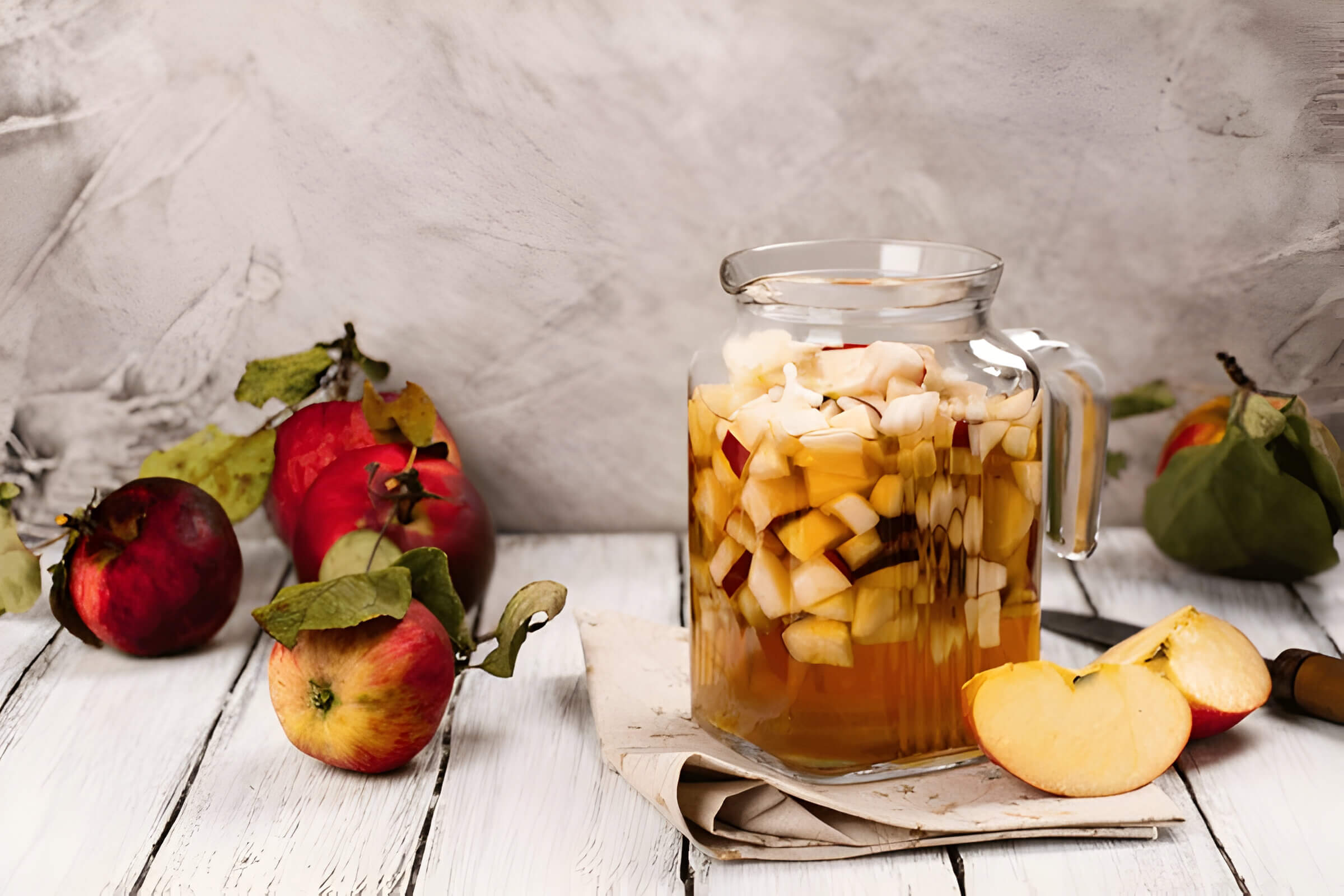
Making vinegar at home is a rewarding and straightforward process that allows you to create a versatile ingredient for your culinary needs. Here’s a step-by-step guide to help you get started with your DIY vinegar recipe.
Step 1. Gather Your Ingredients and Equipment
To start your homemade vinegar batch, you’ll need the following:
– A large glass jar or ceramic container
– Fruit scraps (apples are commonly used)
– Sugar
– Water
– Cheesecloth or a breathable fabric
Step 2. Prepare the Fruit Scraps
Wash your fruit scraps thoroughly to remove any dirt or pesticides. Cut them into small pieces if they aren’t already, ensuring there’s enough surface area for fermentation.
Step 3. Mix the Ingredients
Place the fruit scraps in your container. For every cup of fruit, add one tablespoon of sugar and enough water to cover the fruit completely. Stir well to dissolve the sugar.
Step 4. Cover and Store
Cover the container with cheesecloth or breathable fabric secured with a rubber band. This allows air to circulate while keeping out bugs and debris. Store it in a dark, warm place at room temperature (60-80°F) for about two weeks.
Step 5. Stir Daily
Stir the mixture daily to promote even fermentation. You’ll notice bubbles forming after a few days; this is a sign that fermentation is taking place.
Step 6. Strain and Ferment Further
After two weeks, strain out the solid fruit pieces using a fine mesh sieve or cheesecloth. Transfer the liquid back into the cleaned container, cover it again with cheesecloth, and let it ferment for another three to four weeks.
Step 7. Taste Test and Bottle
Taste your vinegar periodically until it reaches your desired level of acidity. Once satisfied, transfer it into clean bottles with airtight lids for storage.
By following this easy homemade vinegar guide, you’ll have fresh, flavorful vinegar ready for use in salads, marinades, pickling solutions, and more!
Troubleshooting Common Issues in Homemade Vinegar Production
Making your own vinegar at home can be a rewarding experience, but it’s not without its challenges. Understanding the common issues in DIY vinegar production can help you troubleshoot and perfect your process. Here are some typical vinegar making problems and how to fix them:
- Slow Fermentation: One of the most frequent issues is slow or stalled fermentation. This can be caused by low temperatures, insufficient oxygen, or an improper balance of alcohol and acetic acid bacteria. To fix this, ensure that your fermentation vessel is kept at a stable temperature between 60-80°F (15-27°C) and that it has adequate airflow.
- Off-Flavors: If your vinegar develops undesirable flavors, it could be due to contamination from unwanted bacteria or yeast strains. Always use sterilized equipment and clean water to minimize contamination risks. Additionally, using fresh ingredients will help maintain the desired flavor profile.
- Cloudiness: Cloudy vinegar often results from suspended particles or bacterial growth during fermentation. While cloudiness isn’t harmful, it may affect the appearance of your product. Filtering the vinegar through cheesecloth after fermentation can help achieve a clearer result.
- Low Acidity: If your homemade vinegar lacks acidity, it might not have fermented long enough or may require more sugar to feed the acetic acid bacteria properly. Extending the fermentation period and ensuring an adequate sugar source (like fruit juice or wine) should enhance acidity levels.
- Mold Growth: Mold on top of your fermenting liquid is a sign that something went wrong with hygiene practices or environmental conditions were too humid and warm without proper ventilation. Remove any moldy layers carefully without disturbing the rest of the batch and adjust storage conditions accordingly.
By addressing these common issues in DIY vinegar production, you can improve both the quality and consistency of your homemade vinegars, turning potential mistakes into valuable learning experiences for future batches!
The Benefits and Uses of Homemade Vinegar
Homemade vinegar offers a plethora of benefits and uses that make it a valuable addition to any household. One of the primary advantages of homemade vinegars is their purity and natural composition. Unlike commercial varieties, which may contain additives and preservatives, DIY vinegars are free from artificial ingredients, ensuring a healthier option for consumption.
The health benefits of natural vinegars are extensive. Rich in acetic acid, homemade vinegar can aid in digestion, help regulate blood sugar levels, and even support weight loss efforts. Additionally, the probiotics found in naturally fermented vinegars contribute to a healthy gut microbiome, enhancing overall well-being.
Beyond health advantages, the uses for DIY vinegars are incredibly versatile. In the kitchen, they serve as excellent bases for salad dressings, marinades, and pickling solutions. Their unique flavors can elevate dishes by adding depth and complexity. Outside of culinary applications, homemade vinegars can be used for cleaning purposes due to their antibacterial properties. They effectively remove stains and odors without relying on harsh chemicals.
In conclusion, the benefits and uses of homemade vinegar extend far beyond its basic function as an acidic ingredient. From promoting better health to providing eco-friendly cleaning solutions, natural vinegars offer numerous advantages that make them worth considering for any DIY enthusiast or health-conscious individual.
Food & Beverage
Is Swai Fish Healthy? Benefits and Risks

Swai fish, also known as Pangasius or iridescent shark, is a type of catfish commonly found in Southeast Asia, particularly Vietnam. It has gained popularity worldwide due to its mild flavor and affordability. But is Swai fish healthy? Let’s explore its nutritional profile, health benefits, potential risks, and the sustainability of its farming practices.
What is Swai Fish?
Swai fish, also known as Pangasius hypophthalmus, is a type of freshwater fish that belongs to the catfish family. Originating from the Mekong River in Southeast Asia, particularly Vietnam, swai has gained popularity worldwide due to its mild flavor and affordable price. This versatile fish is often used in various culinary dishes ranging from grilled fillets to fried and baked recipes.
One of the primary health benefits of swai fish is its relatively low calorie and fat content. A typical serving provides a good source of protein while maintaining a lower fat profile compared to other types of fish. Additionally, swai contains essential nutrients such as omega-3 fatty acids, which are known for their heart health benefits. These nutrients can help reduce inflammation and improve cardiovascular health.
However, it’s important to consider the origins and farming practices when choosing swai fish. Much of the commercially available swai comes from large-scale aquaculture operations in Vietnam where farming practices can vary significantly. Opting for responsibly sourced or certified swai ensures that you are consuming a product that meets higher standards for environmental impact and food safety.
Swai fish offers an affordable and nutritious option for those looking to incorporate more seafood into their diet. By understanding its origins and ensuring responsible sourcing, consumers can enjoy this versatile fish while benefiting from its health advantages.
Nutritional Profile of Swai Fish
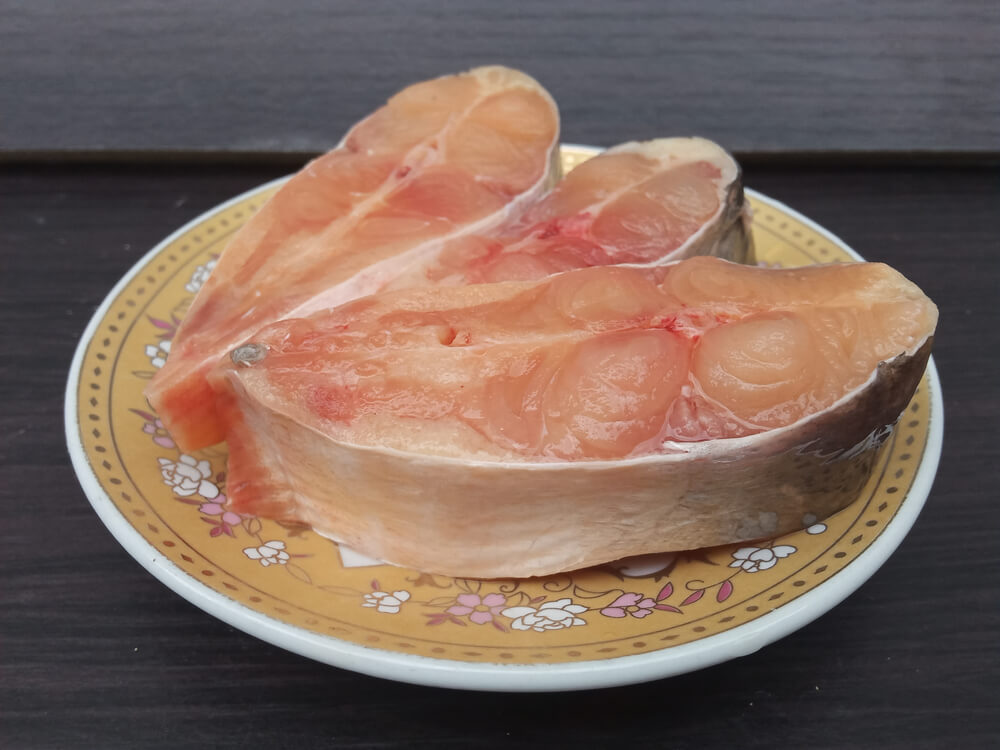
Swai fish, also known as Pangasius or iridescent shark, is a popular choice for those seeking an affordable and mild-tasting seafood option. Understanding the nutritional profile of swai fish can help you make informed dietary choices.
When it comes to swai fish nutrition facts, a standard 4-ounce serving of cooked swai fillet contains approximately 90-100 calories. This makes it a low-calorie option suitable for those monitoring their caloric intake. In terms of protein content, the same serving size provides around 15 grams of protein, which is essential for muscle repair and growth.
Swai fish also offers a modest amount of essential nutrients. It contains small quantities of vitamins such as B12 and minerals like selenium and phosphorus. However, it’s worth noting that the nutritional value of swai fillet may not be as high in omega-3 fatty acids compared to other types of fatty fish like salmon or mackerel.
Swai fish is a low-calorie source of protein with some essential vitamins and minerals. While it may not be the most nutrient-dense seafood option available, its affordability and mild flavor make it an appealing choice for many households looking to incorporate more seafood into their diet.
Health Benefits of Eating Swai Fish
Swai fish, a type of catfish native to Southeast Asia, has become increasingly popular in many diets due to its health benefits and versatility in cooking. One of the primary questions people often ask is: “Is eating swai healthy?” The answer is yes, and here’s why.
Firstly, swai fish is an excellent source of low-calorie protein. A single serving provides a significant amount of protein while keeping calorie intake minimal, making it an ideal choice for those looking to maintain or lose weight without sacrificing essential nutrients.
Another notable benefit is the presence of omega-3 fatty acids in swai fish. Omega-3s are well-known for their positive effects on heart health. Consuming these fatty acids can help reduce inflammation, lower blood pressure, and decrease the risk of heart disease. Including swai fish in your diet can be a delicious way to support cardiovascular wellness.
In addition to being heart-healthy and low in calories, swai fish also offers essential vitamins and minerals that contribute to overall well-being. Its mild flavor allows it to be easily incorporated into various recipes without overpowering other ingredients.
Incorporating swai fish into your diet can provide numerous health benefits such as being a low-calorie protein source and supporting heart health through its omega-3 content. As with any food, it’s important to consume it as part of a balanced diet for optimal health benefits.
Potential Health Risks Associated with Swai Fish
Swai fish, a popular choice in many households due to its affordability and mild flavor, has recently come under scrutiny for potential health risks. One of the primary concerns is the mercury levels found in swai fish. Although generally considered low compared to other seafood, it’s important to monitor mercury intake, especially for vulnerable populations like pregnant women and young children.
Another significant issue is the presence of contaminants in swai fish. Being an imported seafood primarily farmed in Southeast Asia, swai often comes from regions where water quality regulations may not be as stringent as those in other parts of the world. This raises questions about the safety and cleanliness of these farming practices.
The broader topic of imported seafood risks also plays a role here. Imported fish can sometimes bypass rigorous safety checks, leading to potential exposure to harmful substances. This makes it crucial for consumers to be aware of where their seafood originates and how it was produced.
When comparing farmed vs wild-caught seafood safety, farmed swai often falls short due to overcrowded conditions that can lead to disease and contamination. While wild-caught options may offer a safer alternative, they are generally more expensive and less readily available.
While swai fish remains a budget-friendly option for many families, it’s essential to weigh these potential health risks carefully. Opting for well-regulated sources or choosing alternative types of fish with lower contaminant levels can help ensure a healthier diet without compromising on safety.
Sustainability and Environmental Concerns about Swai Farming
Swai, a type of catfish commonly found in Southeast Asia, has become a popular choice for consumers seeking affordable seafood. However, the sustainability and environmental impact of swai farming raise significant concerns that deserve attention.
One of the primary issues with swai farming is its environmental impact. Intensive aquaculture practices often lead to water pollution due to the discharge of fish waste, uneaten feed, and chemicals used in farming operations. This pollution can degrade local water quality and harm aquatic ecosystems. Additionally, the high density at which swai are farmed increases the risk of disease outbreaks, necessitating the use of antibiotics that can further contaminate water bodies.
Ethical concerns also come into play when discussing swai farming. Many farms operate under conditions that may not meet stringent animal welfare standards. Overcrowding and poor living conditions can lead to stress and suffering for the fish, raising questions about the ethicality of such practices.
For those looking to make sustainable seafood choices, it is crucial to consider these factors when purchasing swai. Opting for products certified by reputable sustainability organizations or choosing alternative species with lower environmental footprints can help mitigate some of these concerns.
While swai offers an economical option for seafood lovers, its farming practices present several sustainability and ethical challenges. Being informed about these issues allows consumers to make more responsible choices that support both environmental health and ethical aquaculture practices.
Should You Add Swai Fish to Your Food?
When considering whether to include Swai in your diet, it’s crucial to weigh both its benefits and potential drawbacks. Opting for responsibly sourced Swai from reputable suppliers can mitigate some of these concerns. As with any food choice, moderation is key.
In conclusion, while Swai fish can be a cost-effective and adaptable addition to your meals, ensuring you choose high-quality sources will help you enjoy its benefits without compromising on safety or sustainability.
-

 Fashion
FashionHow to Measure Ring Size Accurately at Home
-

 Home & Family
Home & FamilyHow to Unclog a Toilet (A Step-by-Step Guide for Quick and Easy Fixes)
-

 Destinations
DestinationsThings to Do in Salt Lake City (Attractions, Activities, and More)
-
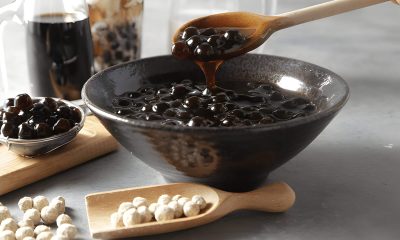
 Food & Beverage
Food & BeverageWhat is Boba Made Of and How to Make It
-

 Internet Business
Internet BusinessHow to Handle Blackmail on Snapchat (A Guide to Protecting Yourself)
-

 Home & Family
Home & FamilyBox Elder Bugs- Identification, Habitats, and Control
-

 Destinations
Destinations7 Things to Do in Pigeon Forge with Kids- Creating Unforgettable Family Memories
-

 Fishing
FishingWahoo Fishing (Tips, Techniques, and Gear)

